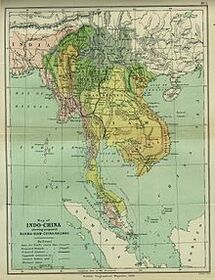
Indo-China is a peninsula at the southeastern extremity of the Eurasian continent. Indo-China has been inhabited by hominid species for over a million years. Modern humans reached the area roughly 45,000 years ago. The inhabitants have engaged in maritime trade for some 7,000 years with the many islands off the Indo-Chinese coast.
Trade links with India resulted in growing Indian cultural influence in Indo-China from 400 BC onwards, including the Hindu and Buddhist religions. A group of city-states called the Funan appeared in the first century in the Mekong delta, and were succeeded by the Chenla in the late sixth century. The Chenla in turn were conquered by the Khmer Empire in the early ninth century. At the same time, the coastal area east of Funan and Chenla was occupied by the Chamla civilization, which also adopted Indian culture and the Hindu religion. North of Chamla was the kingdom of Vietnam, a Chinese province that broke away from Tang China in the early tenth century. A series of wars between Vietnam and Chamla ended in the fifteenth century with the conquest of Chamla by Vietnam.
The Thai people of northwestern Indo-China broke away from the Khmer Empire in the thirteenth century, and a series of wars between the Thai and the Khmer led to the fall of the Khmer Empire in the fifteenth century, after which it was succeeded by the kingdom of Cambodia. The Thai kingdom of Ayutthaya grew in power, despite a series of wars in the seventeeth and eighteenth centuries with Burma. A Burmese invasion in 1767 caused the Ayutthaya kingdom to collapse, and it was replaced by a new Thai kingdom based initially in Thonburi, and later in Bangkok. By the turn of the nineteenth century the Thai kingdom had conquered all of Indo-China between Burma and Vietnam.
It seems likely that Indo-China remained free of European colonialism during the nineteenth century. Great Britain had established control over India and Australia, while merchant traders from the Germanic Confederation and France competed with the British, and each other, in Africa, South America, and China. The Mexican conquest of Siberia in 1899 brought Japan out of its isolation and into a defensive alliance with the British. It is likely that the British encouraged their Japanese allies to establish protectorates over Indo-China and Taiwan to forestall intrusions there by the Germans. Nevertheless, by the 1930s, growing German and Mexican influence in China was threatening Japanese control over Indo-China.
The outbreak of the Global War between Britain and Germany in 1939 was initially confined to Europe and the Near East, but a German offensive into India in 1940 brought German forces to the borders of Indo-China by the end of the year. The Germans drove the Japanese from Indo-China in 1941 and began landing forces in the Dutch East Indies, with the ultimate goal of conquering Australia. The Germans became bogged down in the East Indies, and were forced to withdraw from Borneo late in 1942. The outbreak of a large-scale uprising in German-occupied Europe in 1945 led to the complete withdrawal of German forces from Indo-China. Sobel notes that since the withdrawal of German forces, Indo-China has become a battleground for rival warlords.